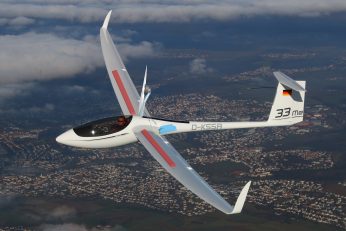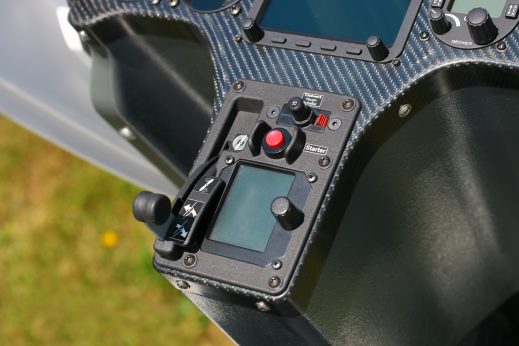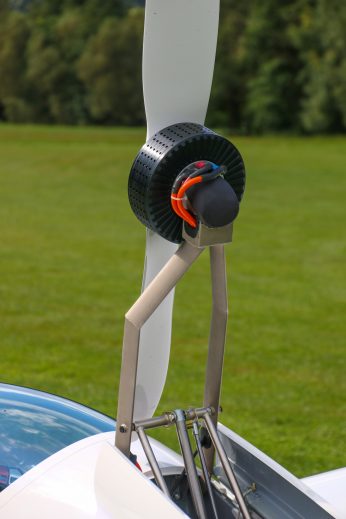The AS 33 will become an Electric Self-launcher!
Our new 18m sailplane will be equipped with an electric propulsion system with the type designation AS 33 Me.
In the meantime, with the ASG 32 El “turbo” system and the self-launching AS 34 Me we already have two electrical propulsion systems in or close to series production. At the same time, the interest among soaring pilots for electric flying is continuously increasing. Simple operation and reduced maintenance requirements are powerful arguments in this regard.
Self launching and sufficient reserve
Up to now, the sleek fuselages of our 18m competition sailplanes did not permit the installation of our powerful and many times proven Wankel engine and therefore made self-launching impossible. Now more and more new possibilities for soaring are opened up by the simpler and more compact layouts of the electric systems.
Therefore, the logical consequence is to use the electric propulsion system developed for the AS 34 Me to turn the 18m competition sailplane AS 33 into a self-launcher and use the designation AS 33 Me for it. But that only makes sense if, after a self-launch – and furthermore with a maximum take-off weight of 600 kg – sufficient battery capacity remains for a powered flight to home base. The AS 33 Me will have a reach of more than 120 km for such flights.
Safety and simplest operation
The Lithium-Ion batteries, located the inner wings and surrounded by a safety housing, power the retractable 35 kW EMRAX motor in the fuselage. A specially developed propeller, designed and manufactured by Schleicher, provides the necessary, powerful thrust. The power electronics is also located in the engine bay.
The simple and very intuitive controls of the electric drive system – as for the AS 34 Me – have been located in the lower part of the instrument panel. The control instrument with its colour display is also installed there, providing information about the battery charge state, engine RPMs and temperatures with one quick look.
A cleverly designed battery management system (BMS) monitors the wing battery cells during power discharge as well as during the charging phase.
An additional significant advantage of the electric drive system is that climb performance does not noticeably decrease at high altitudes, while combustion engines do have a clear performance drop in that situation. As well, the completely retracted propulsion unit causes absolutely no extra drag while soaring.
AS 33 Me and AS 33 Es!
Nevertheless, the AS 33 will continue to be available in the “Es” version as a pure sustainer system based on the two-cylinder, two-stroke Solo 2350 engine, in order to provide even greater flexibility for wing loading possibilities in competitions. With this system as well, utilizing an electric starter and an innovative engine control system, we provide an overall system operation which cannot be more simple and reliable, completely comparable to the electric drive version.
Technical Data
| Span | 18 m | 59 ft |
| Wing area | 10 m² | 107.6 sqft |
| Wing aspect ratio | 32.4 | |
| Empty mass | 415 kg | 915 lbs |
| Max. take-off mass | 600 kg | 1322 lbs |
| Min. wing loading | 47.7 kg/m² | 9.8 lbs/sqft |
| Max. wing loading | 60 kg/m² | 12.3 lbs/sqft |
| Min. sink | 0,52 m/s | 102 ft/min |
| Best glide ratio | 56 |
EMRAX motor (air cooled)
| Max. power | 35 kW | |
| Max. continuous power | 25 kW | |
| Battery capacity | 8.6 kWh |
Powered flight performance (500 kg / 1100 lbs)
| Ground roll distance | 270 m | 886 ft |
| Take-off dist. (15 m barrier) | 400 m | 1313 ft |
| Rate of climb (35 kW) | 3,6 m/s | 708 ft/min |
Remaining propulsion capacity
| after take-off to 500 m (25 kW, 500 kg) | ||
| Rate of climb | 2,3 m/s | 452 ft/min. |
| Climbing altitude | 2150 m | 6900 ft |
| Range | 130 km | 80 mi / 70 nm |
Design and construction subject to change without prior notice.
We would be happy to provide additional information about the possible equipment variations by providing a quote. Simply contact us at: sales@alexander-schleicher.de




